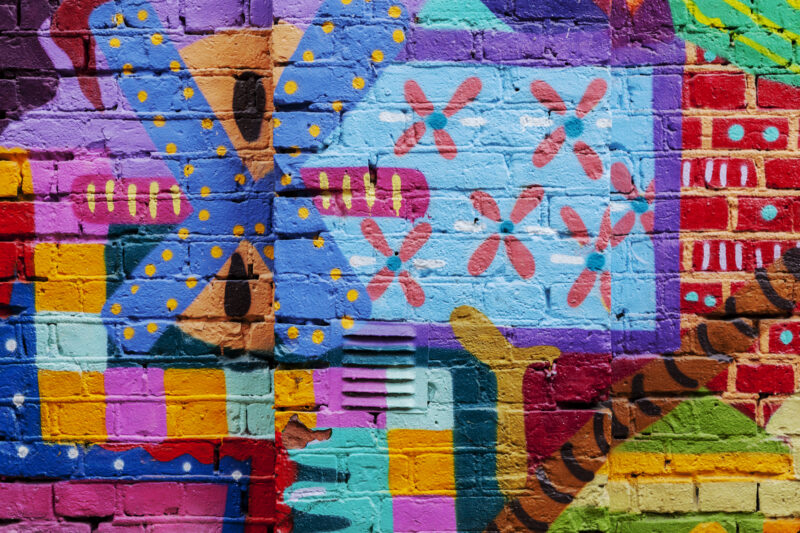Copyright in graffiti is an interesting and relatively unexplored area of law in Canada. It is still unclear what kinds of protections a graffiti artists’ work can be afforded, but by looking at the relevant sections of the Copyright Act and examples of caselaw on related topics, it is possible to make predictions about how some of the main issues surrounding the subject might be dealt with by Canadian law. Continue reading for an exploration into the issues relating to reproduction and moral rights that graffiti might pose for Canadian courts and what they might consider if such issues were to appear before them.
Does Copyright Subsist in Graffiti?
Canadian courts have not yet definitively ruled on whether or not graffiti attracts copyright protection, but based on the Copyright Act, it seems likely that it would.
As per section 5(1) of the Copyright Act, copyright subsists in every original literary, dramatic, musical, and artistic work, provided certain conditions are met, such as it existing in a fixed form. There is no requirement that the work must be created in some sort of “lawful” manner. So if a graffiti artist creates an original artistic piece in a material format such as on the side of a building, this piece should in theory attract automatic copyright protection like any other original, fixed artistic work.
The Issue of Reproduction
One of the concerns that has arisen in the US and that will eventually have to be dealt with by the Canadian court system when it arises in Canada, is what happens if a work of graffiti appears in the background of another work? The right of reproduction in the Copyright Act keeps individuals from incorporating copyrightable art in their own works without permission from the copyright owner.
An example of reproduction would be photographing a work of art for a magazine. The photographer reproducing the work of art in a photographic form technically requires the permission of the owner of the work of art’s copyright before reproducing it. So if a work of graffiti appears in a photograph of a building, is this infringement?
The answer is that it would depend. If copyright subsists in graffiti, then to prominently and purposefully reproduce it in a photograph will probably raise issues. However, there are two sections of the Copyright Act that are worth highlighting because they might provide possible defences to an infringement claim if someone reproduces a work of graffiti in another work without the artist’s permission: section 30.7. and section 32.2(1)(b).
- Section 30.7 deals with incidental use of a work. It states that it is not an infringement of copyright to include a work in another work “incidentally and not deliberately.” This means that if a work of graffiti is shown in the background of a picture or a video by accident, the infringer might be able to defend that use on the basis of incidental inclusion.
- Section 32.2(1)(b) deals with permitted acts. It states that it is not an infringement of copyright to reproduce a work of artistic craftsmanship that is permanently situated in a public place or building. This means that if a work of graffiti in a public space could arguably be considered a work of “artistic craftmanship,” it may not be considered infringement to have it present in a photograph or video.
As well, it is worth noting that as with any use of copyrightable works, the common fair dealing exceptions under section 29 of the Act may also apply to the use of a copyrightable piece of graffiti if the use/reproduction’s purpose falls under the categories of research, private study, education, parody, or satire.
The Issue of Moral Rights
Another major copyright concern that arises from the creation of graffiti is the issue of moral rights. Moral rights offer artists (a) the right to be associated with their work and (b) the right to the integrity of their work. The right of integrity is the right not to have a work modified or associated with a good or service that could damage the artist’s reputation.
“Destruction” of a work in its entirety does not amount to a violation of an artist’s moral rights because once the work is gone, there is no possibility of the author’s reputation being damaged by it any longer and to suggest otherwise would problematically allow for the preservation of an artist’s moral rights even after their work no longer exists. However, in the past, Canadian courts have awarded damages to artists for the destruction of a large portion of their work, categorizing the almost complete demolition as “mutilation” of the work that amounts to a violation of an artist’s integrity (see: Vaillancourt c Carbone 14, [1998] JQ no 3905). The question then becomes whether the right of integrity would allow a graffiti artist to claim an infringement of their moral rights if someone were to “mutilate” or deface their work.
The answer is that it is possible. The Canadian courts have not yet had any cases before them that would allow them to decide on this issue, but if it were to come before them, it is possible that they could view graffiti in the same way that they view other artistic works and afford it the same protections, even with regards to moral rights. However, it is also possible that the courts could offer graffiti copyright protection, but treat it similarly to copyrightable works like obscene materials. Canadian courts have found that copyright can subsist in obscene materials, but they have limited the remedies available for the infringement of said materials (see: Aldrich v One Stop Video Ltd, [1987] BCJ No 1035). The similarly oftentimes criminal nature of graffiti and the fact that the mutilation of graffiti could arguably be an act that does not damage a graffiti artist’s reputation in the same way as the mutilation of another artist’s work could potentially mean that courts would be reticent to grant a graffiti artist all of the remedies that are normally available to artists whose rights are infringed.
Takeaways
The extent of a graffiti artist’s right to protection and remuneration in relation to any infringement of their work will most likely eventually have to be determined by the Canadian court system, but in the interim, those who are looking to either use graffiti in the background of videos or photography or perhaps looking to publicly alter or deface someone’s already created graffiti work should be mindful that doing so could potentially engage the rights of the graffiti artist.
Les graffitis sont-ils protégés par le droit d’auteur? Si oui, quels enjeux juridiques cela peut-il soulever?
Le droit d’auteur relativement aux graffitis est un domaine du droit intéressant et relativement peu exploré au Canada. On ne sait toujours pas quelles protections peuvent être accordées à l’œuvre d’un graffiteur, mais en examinant les articles pertinents de la Loi sur le droit d’auteur et certains exemples de jurisprudence sur des sujets connexes, on peut prédire la façon dont certaines des principales questions entourant le sujet pourraient être traitées par le droit canadien. Poursuivez votre lecture pour explorer les questions liées aux droits de reproduction et aux droits moraux que les graffitis pourraient poser aux tribunaux canadiens et pour savoir quels éléments pourraient être considérés par les tribunaux si de telles questions devaient leur être présentées.
Les graffitis font-ils l’objet d’un droit d’auteur?
Les tribunaux canadiens ne se sont pas encore prononcés de façon définitive quant à savoir si les graffitis bénéficient ou non de la protection du droit d’auteur, mais selon la Loi sur le droit d’auteur, il semble probable que oui.
En vertu du paragraphe 5(1) de la Loi sur le droit d’auteur, le droit d’auteur existe sur toute œuvre littéraire, dramatique, musicale ou artistique originale, tant que certaines conditions soient remplies, notamment l’existence de l’œuvre sous une forme fixe. Rien n’exige que l’œuvre soit créée d’une quelconque manière « licite ». Ainsi, si un graffiteur crée une œuvre artistique originale sur un support physique, par exemple sur le côté d’un immeuble, cette œuvre devrait en théorie bénéficier automatiquement de la protection du droit d’auteur, au même titre que toute autre œuvre artistique originale et fixe.
La question de la reproduction
L’une des préoccupations qui a été soulevée aux États-Unis, et qui devra éventuellement être examinée par le système judiciaire canadien lorsqu’elle se présentera au Canada, est la question de savoir comment procéder si un graffiti apparaît en arrière-plan d’une autre œuvre. Le droit de reproduction prévu par la Loi sur le droit d’auteur empêche toute personne d’incorporer des œuvres d’art protégées par le droit d’auteur dans leurs propres œuvres sans l’autorisation du titulaire du droit d’auteur.
Un exemple de reproduction serait la photographie d’une œuvre d’art pour un magazine. Le photographe reproduisant l’œuvre d’art sous une forme photographique devrait techniquement obtenir l’autorisation du titulaire du droit d’auteur de l’œuvre d’art avant de la reproduire. Donc, si un graffiti apparaît sur une photographie d’un immeuble, est-ce une violation du droit d’auteur?
La réponse : cela dépend. Si un droit d’auteur existe sur le graffiti, le reproduire de manière visible et délibérée sur une photographie soulèvera probablement des enjeux. Toutefois, deux dispositions de la Loi sur le droit d’auteur méritent d’être soulignées, car elles pourraient constituer des moyens de défense possibles contre des revendications liées à une violation si quelqu’un reproduisait un graffiti dans une autre œuvre sans la permission de l’artiste : l’article 30.7 et l’alinéa 32.2(1)b).
- Il précise que le fait d’incorporer une œuvre dans une autre œuvre « de façon incidente et non délibérée » ne constitue pas une violation du droit d’auteur. Cela signifie que si un graffiti est montré en arrière-plan d’une photo ou d’une vidéo par accident, le défendeur pourrait être en mesure de justifier cet usage en invoquant l’incorporation incidente.
- Il précise que la reproduction d’une œuvre artistique due à des artisans érigée en permanence sur une place publique ou dans un édifice public ne constitue pas une violation du droit d’auteur. Cela signifie que si un graffiti sur une place publique pourrait vraisemblablement être considéré comme une œuvre « artistique due à des artisans », sa présence sur une photographie ou une vidéo pourrait ne pas être considérée comme une violation du droit d’auteur.
De plus, il convient de souligner que, comme pour toute utilisation d’œuvres protégées par le droit d’auteur, les exceptions usuelles pour utilisation équitable prévues à l’article 29 de la Loi peuvent également s’appliquer à l’utilisation d’un graffiti protégé par le droit d’auteur si l’utilisation ou la reproduction est faite aux fins de recherche, d’étude privée, d’éducation, de parodie ou de satire.
La question des droits moraux
Une autre préoccupation majeure en matière de droit d’auteur qui découle de la création de graffitis est la question des droits moraux. Les droits moraux offrent aux artistes a) le droit de se faire attribuer leur œuvre, et b) le droit à l’intégrité de leur œuvre. Le droit à l’intégrité est le droit à ce que l’œuvre ne soit pas modifiée ni utilisée en liaison avec un produit ou un service d’une manière préjudiciable à la réputation de l’artiste.
La « destruction » d’une œuvre dans son intégralité ne constitue pas une violation des droits moraux d’un artiste, car une fois l’œuvre disparue, il n’est plus possible que celle-ci puisse porter préjudice à la réputation de l’auteur, et prétendre le contraire permettrait, de manière problématique, de faire en sorte que les droits moraux d’un artiste survivent même après la disparition de son œuvre. Or, dans le passé, les tribunaux canadiens ont accordé des dommages-intérêts à des artistes pour la destruction d’une grande partie de leur œuvre, catégorisant la démolition presque complète comme étant une « mutilation » de l’œuvre et constituant une atteinte à l’intégrité de l’artiste (voir : Vaillancourt c Carbone 14, [1998] JQ no 3905). Il faut donc se demander si le droit à l’intégrité permettrait à un graffiteur de prétendre à une atteinte à ses droits moraux si quelqu’un devait « mutiler » ou dégrader son œuvre.
La réponse : cela est possible. Les tribunaux canadiens n’ont pas encore été saisis d’affaires qui leur permettraient de trancher cette question, mais s’ils devaient en être saisis, il est possible qu’ils puissent considérer les graffitis de la même façon qu’ils considèrent les autres œuvres artistiques et leur accorder les mêmes protections, même en ce qui concerne les droits moraux. Toutefois, il est également possible que les tribunaux accordent la protection du droit d’auteur à l’égard des graffitis, mais qu’ils les traitent de la même façon que les œuvres protégées par le droit d’auteur comme le matériel obscène. Les tribunaux canadiens ont jugé que le matériel obscène peut être protégé par le droit d’auteur, mais ils ont limité les recours possibles en cas de violation du droit d’auteur rattaché à ce matériel (voir : Aldrich v One Stop Video Ltd, [1987] BCJ No 1035). La nature souvent criminelle des graffitis, et le fait que la mutilation de graffitis pourrait sans doute être un acte qui ne porte pas atteinte à la réputation du graffiteur de la même façon que la mutilation de l’œuvre d’un autre artiste pourrait le faire, pourraient éventuellement amener les tribunaux à se montrer réticents à accorder à un graffiteur les recours habituellement offerts aux artistes victimes d’une violation de leurs droits.
Ce qu’il faut retenir
L’étendue du droit d’un graffiteur à la protection et à la rémunération relatives à la violation de son œuvre devra très probablement éventuellement être déterminée par le système judiciaire canadien. Entre-temps, si vous souhaitez utiliser des graffitis en arrière-plan de vidéos ou de photographies, ou si vous souhaitez modifier ou dégrader publiquement un graffiti déjà créé, souvenez-vous que cela pourrait potentiellement mettre en cause les droits du graffiteur.



